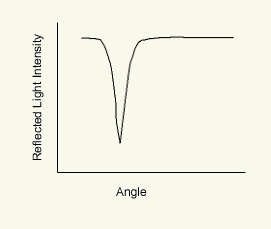 Surface Plasmon Resonance (SPR) is an optical detection process that occurs when a polarized light hits a prism covered by a thin (gold) metal layer. Under certain conditions (wavelength, polarization and incidence angle) free electrons at the surface of the bio-sensor chip absorb incident light photons and convert them into surface plasmon waves. A dip in reflectivity of the light is seen under these SPR conditions.
Surface Plasmon Resonance (SPR) is an optical detection process that occurs when a polarized light hits a prism covered by a thin (gold) metal layer. Under certain conditions (wavelength, polarization and incidence angle) free electrons at the surface of the bio-sensor chip absorb incident light photons and convert them into surface plasmon waves. A dip in reflectivity of the light is seen under these SPR conditions.
Perturbations at the gold surface of the bio-sensor chip, such as an interaction between probe molecules immobilized on the chip and captured target molecules, induce a modification of resonance conditions which are in turn seen as a change in reflectivity and which can be measured. This is the basis application of the SPR measurements, such as using a Biacore system.
